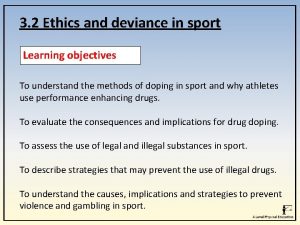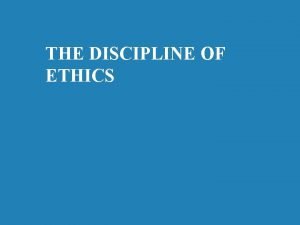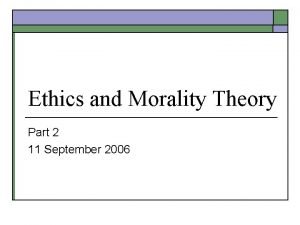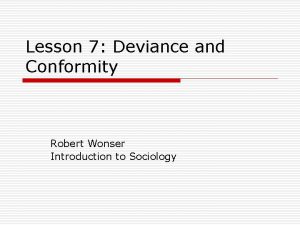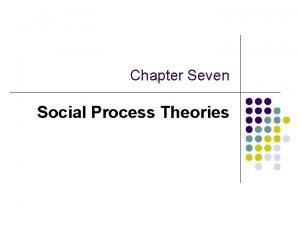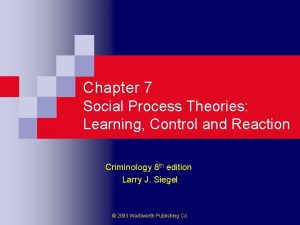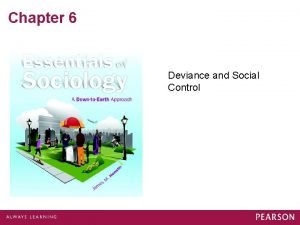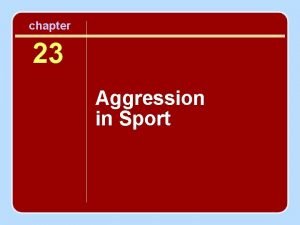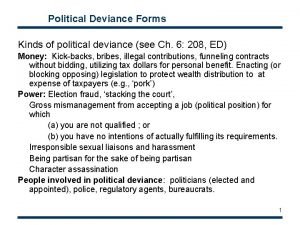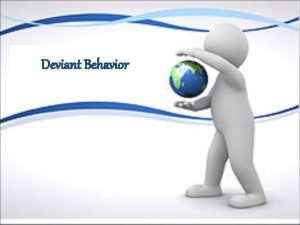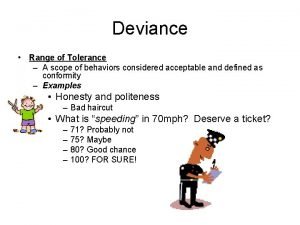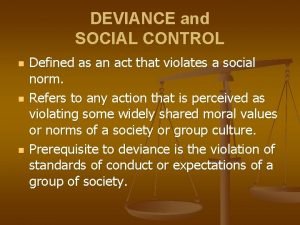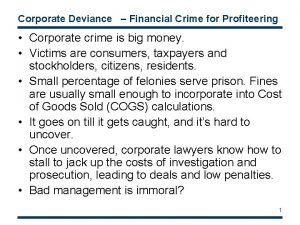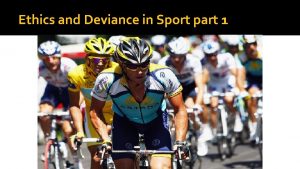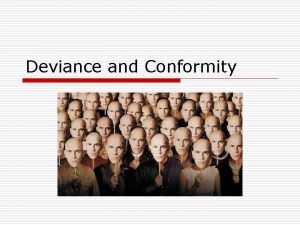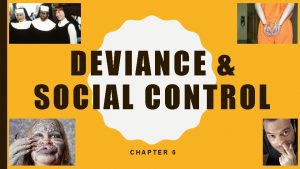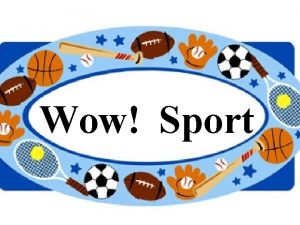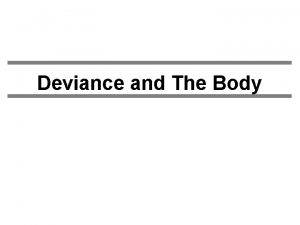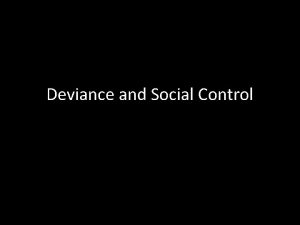3 2 Ethics and deviance in sport Learning
















































- Slides: 48

3. 2 Ethics and deviance in sport Learning objectives To understand the methods of doping in sport and why athletes use performance enhancing drugs. To evaluate the consequences and implications for drug doping. To assess the use of legal and illegal substances in sport. To describe strategies that may prevent the use of illegal drugs. To understand the causes, implications and strategies to prevent violence and gambling in sport.

Ethics and deviance Sport and physical activity can be affected by poor sportsmanship and ethics. Unethical behaviour includes the use of performance enhancing drugs. Deviance is any unacceptable behaviour that differs from the perceived social and legal norms. Think. Pair. Share – What behaviours or acts would be seen as deviant?

Ethics and deviance Deviant behaviour is usually as a result of a drive to win being blocked. Pressures from coaches, sponsorships deals and spectators can also increase the level of deviance seen. Deviance can be seen in sport through: • Violence • Hooliganism • Gambling • Match fixing • Doping Often TV and other media outlets are responsible for reporting, and on occasions ‘hyping up’, news stories and rivalries.

Drugs and Doping in Sport Watch me What sports or athletes have been involved in recent incidents of drug taking in sport?

Blood doping is the practice of boosting the number of red blood cells in the bloodstream in order to enhance performance. An increase in number of red blood cells will increase the amount of haemoglobin present (oxygen-carrying protein) This allows higher amounts of oxygen to reach an athlete's muscles. This can improve stamina and performance, particularly in longdistance events, such as running and cycling.

Blood doping The blood doping method is outlined below. 1. Blood (up to 2 pints) is removed from competitor and stored several weeks before competition. 2. Body naturally synthesises new blood cells to replace those lost. 3. Blood injected back in to the body 1 -2 days before competition.

Blood doping is banned by the International Olympic Committee and other sports organisations. By increasing the number of red blood cells, blood doping causes the blood to thicken. This thickening forces the heart to work harder than normal. As a result, blood doping raises the risk of: • blood clots • heart attacks • strokes

Performance Enhancing Drugs Performance enhancing drugs are substances that are used to improve any form of athletic performance. Think. Pair. Share – What performance enhancing drugs are you aware of already?

Performance Enhancing Drugs Beta Blockers • The beta-blocker drugs 'sit' on receptors and stop (block) the receptor from being stimulated. • Effect: slows heart rate, calms and steadies hands • Side effects: Reduces heart rate so low that heart may stop, low blood pressure and causes tiredness Athletes that might use this category of drug: Shooting (target sports), Snooker

Performance Enhancing Drugs Anabolic steroids • This category of drugs is artificially produced testosterone (Male hormone) • Effect: Repair body tissues after stress, promote muscle growth, ability to train harder with less fatigue. • Side effects: Females develop male features. Liver & heart damage. Athletes that might use this category of drug: Athletics power events i. e 100 m, Shot Putt

Performance Enhancing Drugs Narcotic Analgesic • This category of drugs masks pain (paracetamol, morphine, methadone, heroin) • Effect: Reduces pain or an injury • Side effects: Nausea, highly addictive, serious injury Athletes that might use this category of drug: Any events that require pain to be masked.

Performance Enhancing Drugs Diuretics • This category of drugs will promote removal of fluid from the body. • Effect: Rapid weight loss • Side effects: Dehydration, Dizziness or light headed Athletes that might use this category of drug: Boxers & Jockeys

Performance Enhancing Drugs Stimulants • This category of drug stimulates the body physically and mentally (Tea, Coffee, Cocaine) • Effect: Reduces tiredness, increased alertness & endurance • Side effects: Raise blood pressure, hide symptoms of fatigue & addictive Athletes that might use this category of drug: Any event with a sprint start & boxers

Performance Enhancing Drugs Peptide Hormones • This is a naturally occurring hormone in the body but can be synthesised in a laboratory. Erythropoietin (EPO) and Growth Hormones (GH) Are two common peptide hormones • Effect: Increase oxygen transport (increases endurance) • Side effects: Possible blood clots + cardiovascular problems Athletes that might use this category of drug: Cycling, marathon runners (endurance athletes)

Legal supplements versus illegal drugs in sport Many sports performers use legal substances to maximise training and performance. This includes vitamins, minerals, bicarbonate, carbohydrate gels/drinks and creatine based supplements. These are accepted by sport as they do not significantly enhance performance or affect the health of an athlete. Little is known of the long term effects of prolonged use of legal supplements.

Legal supplements versus illegal drugs in sport Advantages and disadvantage of taking legal substances: Advantages Disadvantages • Provides a boost to health and well-being. • Can help recovery process and building muscle. • Available in a range of formats which make it easier to administer. • Increased chances of success. • Some supplements may contain banned substances or are not what they seem to be. • Research has yet to confirm if there is any long term effects of persistent usage. • Many energy drinks are high in sugar and other health issues such as obesity or tooth decay might prevail. • Not in the spirit of fair play in sport.

Elite performers and illegal drugs/doping The number of cases where elite athletes have failed drugs tests are on the rise. Think. Pair. Share – Why do elite performers use illegal drugs?

Elite performers and illegal drugs/doping 1. Pressure to succeed Elite athletes are under a huge amount of pressure from competitors, coaches, family and themselves to win. This pressure can cause individuals to make poor decisions/judgements. Political pressures are also common motivating factors especially during home games or events. Politicians enjoy a nation’s success and can lead to a win at all cost attitude. The Russian athletics scandal highlights the pressure placed on coaches to produce gold medal winning performances.

Elite performers and illegal drugs/doping 2. Rewards In today’s sport, winning and success leads to a higher profile, increased appearance fees and lucrative sponsorship deals. Prize money/fame can motivate athletes to cheat and take performance enhancing drugs.

Elite performers and illegal drugs/doping 3. To match the competitors In some events drug abuse has become so common that athletes often say ‘if everyone else is, then I will follow in order to keep up’ It is difficult to constantly detect new drugs being used by athletes and some believe doping is just a part of sport. i. e. Over the last decade the Tour de France has had widespread drug doping problems.

Consequences and implications of doping Athletes should be aware that doping can have severe health and social consequences. Doping is a form of negative deviancy/cheating. Performers gain an unfair advantage and undermines the integrity of sport. Health risks to the performer are clear ranging from organ defects to severe long lasting damage to the body, and even death.

Consequences and implications of doping Sports that have been constantly linked to cases of drug taking have had their reputation damaged. As a result it can be difficult to gain sponsorship deals and will lose public following. Negative press can cause sponsors to withdraw from deals due to their brand being associated and called into question. Sports are under increasing pressure to ensure it has a clean image. This has resulted in harsher punishments and stricter testing procedures.

Consequences and implications of doping Elite sport is traditionally seen as fair contest between individuals and is an opportunity to watch athletes perform at the highest level. Society cannot accept or condone acts of drug taking/doping in sport without individual’s being challenged. Such behaviours go against the cultural norms and values of society.

Strategies to help stop the use of drugs in sport Watch me Can doping ever be eliminated from sport? How?

Strategies to help stop the use of drugs in sport WADA is an independent organisation responsible for drug testing and anti-doping programs and research. WADA has a list of banned substances which is regularly updated in the light of new drugs being detected. Think. Pair. Share – What else can WADA do?

Strategies to help stop the use of drugs in sport Regular and random drug testing during and out of competitions will help to deter cheats. Advanced research into new ‘undetectable’ drugs will help to eliminate laboratories who manufacture the illegal drugs used by performers.

Strategies to help stop the use of drugs in sport Education of coaches and athletes will aim to raise awareness of the risks and consequences associated with doping. All governing bodies will have an antidoping program and will visit training institutes and schools to educate young potential athletes. Using both positive and negative role models can help deliver this message.

Strategies to help stop the use of drugs in sport Another strategy in the fight against drugs in sport is the introduction of stricter punishments. In 2015, WADA increased bans to 4 years and a lifetime ban for a second offence. Medals have also been striped from athletes retrospectively and bans extended to coaches too.

Violence in Sport Watch me What are common incidents of violence in sport and what are the reasons for such acts?

Violence in Sport Controlled aggression is a fundamental part of many sports. Sometimes, however, this spills over into an uncontrolled situations where serious physical injury can be caused. Think. Pair. Share – Why do players show acts of violence during sporting contests?

Violence in Sport Violent behaviour can be caused by the following reasons: • Pressures of the media or influences of social media. • Frustration as a result of losing. • Sponsorships deals. • Pressure from spectators / taunting from crowd or opponents. • Rivalries between individuals, teams, nations or religions.

Violence in Sport • As physical retaliation/as a reaction to a challenge/tackle. • Over arousal during the game. • Annoyed by poor decisions by officials. • To gain an advantage / to hurt your opponent controlled aggression may be required for effective play. • As a result of the influence of drugs.

Consequences and implications of violence It is a widespread belief that sport often mirrors society and that violent acts are behaviours influenced by our surroundings. Violent actions on the pitch should be treated the same as violent acts on the street and the law should applied equally. Using positive role models to highlight exemplar behaviour is key to removing violence with younger generations.

Consequences and implications of violence Spectators and followers of certain sports have been known to display acts of violence and even hooliganism. Implications to the sport: • Reputation – a sport can become known for violence and may affect young people taking it up. • Global brand damage – regular violence associated to a sport will affect future sponsorship and investment opportunities.

Consequences and implications of violence Implications of violence for performers are also important to consider. Acts of aggression and violence can result in acute or career ending injuries. To combat violence in sport it is important to educate performers on controlling their emotions and raise awareness of their responsibility as a role model.

Strategies to prevent violence There a number of ways to reduce violence in sport: 1. Education/training: Performers should be trained to deal will stress and emotional control through management techniques. In addition, players must be made aware of how behaviours can be copied by those watching.

Strategies to prevent violence 2. Fair play campaigns: Many governing bodies have introduced fair play programmes and every year nominate teams for fair play awards. 3. Stricter punishments by referees and the sport: Match officials and governing bodies have increased punishments for violent acts and have the power to deal with incidents retrospectively. The threat of such actions is often enough to deter athletes.

Strategies to prevent violence 4. Improved refereeing: Effective officiating is a strategy to avoid confrontation and violence. Many good referees will defuse a potential situation before it arises. Think. Pair. Share – What is the punishment for arguing with the referee in different sports? (Football, Rugby, Netball? )

Strategies to prevent violence 5. Law enforcements and CCTV: The football Disorder Act (2000) allows the police to arrest people identified as potential troublemakers. This act prevent them from travelling abroad. Similar banning orders have been issued to known hooligans. Sophisticated police surveillance helps prevent spectator violence or can be used to track down offenders.

Strategies to prevent violence 5. Responsible media reporting The media (TV, radio, newspaper & internet) and social media outlets have a duty to report and highlight both positive and negative acts of violence in the right way.

Gambling in Sport Watch me How has does match fixing and illegal sports betting work?

Gambling in sport Gambling on sport is not illegal however match fixing and bribery is. Wagering and illegal sport betting has been a part of sport from the 19 th Century during cock fighting and pedestrianism. Many people find it exciting to bet on the outcome of a match or event. Today, online gambling sites & applications make it even easier to place a bet.

Gambling in sport Gambling companies are now also huge sponsors of many sporting teams and events. i. e. Sky Bet football league and William Hill FA Cup Think. Pair. Share – Should this be allowed? Does it encourage gambling?

Match fixing, Bribery and Illegal Betting Match fixing is a global issue with criminals and international ‘fixers’ working all over the world. Players and officials can be approached to fix matches and the outcome of events. Lower league and development football matches, jockeys and even cricket players have been found to be involved in illegal betting and bribery. Match fixing does not happen often in the UK but is a type of deviance and is unethical.

Apply it! What has stuck with you? Discuss the suggestion that performance-enhancing drugs should be allowed in competitive sport. What does illegal sports betting involve? Ethics and deviance in sport Describe the blood doping technique. Explain how violence in sport is being controlled

Practice it! Exam questions 1. Identify one example of an illegal drug used by a sports performer to enhance performance and state one implication of such drug taking on society. [2] Example: Implication: 2. Describe two social implications of violence in sport. [2]

Practice it! Marks Scheme: 1. anabolic steroids • erythropoietin (EPO) • growth hormone (h. GH) • diuretics • masking agents • glucocorticoids • beta blockers • One implication on society (AO 3): • shows up society as ‘win at all costs’ or end result more important than (sports) ethics or that sport is a reflection of (a corrupt) society • to (possibly) ban all athletes who use drugs • to (possibly) accept drug taking or make it legal • to enable more effective drug testing processes • creates negative role models • undermines value to society as part of a healthy lifestyle

Practice it! Marks Scheme: 2. • Sports performers are high profile/role models so violence in elite sport may be copied • Violence in sport can put parents off letting their children participate • Violent behaviour by performers can lead to violence amongst spectators • Sport reflects on society, so if there is violence in sport it is because that is what some people ‘want’/because society is violent/has violence • The importance placed upon sport may create the pressure which leads to the violence • Violence in sport may be a result of other frustration/could indicate other social issues or individual problems
 Deviance in sport
Deviance in sport Pseudo r-square
Pseudo r-square Positive deviance in sport
Positive deviance in sport Overconformity definition
Overconformity definition Micro and macro ethics difference
Micro and macro ethics difference Cuadro comparativo de e-learning
Cuadro comparativo de e-learning What is environmental ethics
What is environmental ethics Briefly summarise
Briefly summarise Factual inquiry in ethics
Factual inquiry in ethics Meta ethics vs normative ethics
Meta ethics vs normative ethics Descriptive ethics vs normative ethics
Descriptive ethics vs normative ethics Beneficence
Beneficence Theological voluntarism
Theological voluntarism Branches of metaethics
Branches of metaethics Deontological
Deontological Teleological ethics vs deontological ethics
Teleological ethics vs deontological ethics Crime and deviance sociology revision
Crime and deviance sociology revision Merton’s typology
Merton’s typology Inner and outer controls work against deviance
Inner and outer controls work against deviance Lesson quiz 7-1 deviance and social control
Lesson quiz 7-1 deviance and social control Chapter 7 deviance crime and social control
Chapter 7 deviance crime and social control Chapter 8 deviance and social control
Chapter 8 deviance and social control Difference between crime and deviance
Difference between crime and deviance Social process theory
Social process theory Primary and secondary deviance
Primary and secondary deviance Involver behavior
Involver behavior Guided reading activity deviance and social control
Guided reading activity deviance and social control What is secondary deviance
What is secondary deviance Deviant sexual behavior examples
Deviant sexual behavior examples Crime and deviance definition
Crime and deviance definition Marxism crime and deviance
Marxism crime and deviance Dysfunctions of deviance
Dysfunctions of deviance Chapter 6 deviance and social control
Chapter 6 deviance and social control Learning curves in sport
Learning curves in sport Frustration-aggression principle
Frustration-aggression principle Example of control theory
Example of control theory Political deviance definition
Political deviance definition Deviancy amplification definition
Deviancy amplification definition Normalization of deviance ppt
Normalization of deviance ppt Functionalist perspective on deviance
Functionalist perspective on deviance Deviance regulation theory
Deviance regulation theory What is deviance
What is deviance Overconforms
Overconforms Criminal deviance
Criminal deviance Acts of deviance
Acts of deviance Financial crime
Financial crime Discouraging criminal acts by threatening punishment
Discouraging criminal acts by threatening punishment Define cultural deviance theory
Define cultural deviance theory Labeling theory of deviance examples
Labeling theory of deviance examples
